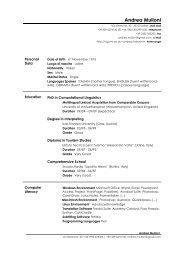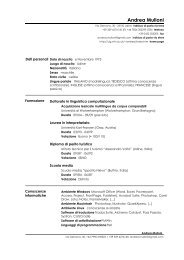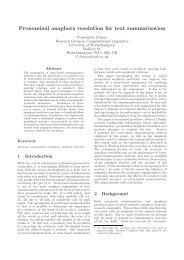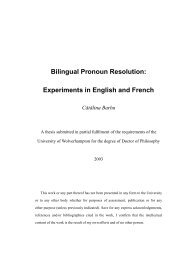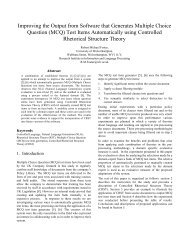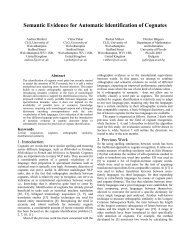Design and development of a concept-based multi ... - Citeseer
Design and development of a concept-based multi ... - Citeseer
Design and development of a concept-based multi ... - Citeseer
Create successful ePaper yourself
Turn your PDF publications into a flip-book with our unique Google optimized e-Paper software.
Shiyan Ou, Christopher S.G. Khoo <strong>and</strong> Dion H. Goh<br />
Fig. 3. A presentation design for the <strong>concept</strong>-<strong>based</strong> <strong>multi</strong>-document summary.<br />
Contextual relations <strong>and</strong> research methods found in the dissertation abstracts are presented first<br />
because these two kinds <strong>of</strong> information are usually quite short <strong>and</strong> may be overlooked by users if<br />
presented at the bottom <strong>of</strong> the summary. However, presenting them in this way has the disadvantage<br />
that they are presented out <strong>of</strong> context. Contextual relations <strong>and</strong> research methods are closely<br />
related to specific research <strong>concept</strong>s <strong>and</strong> relationships investigated in the dissertations, <strong>and</strong> provide<br />
details <strong>of</strong> how the <strong>concept</strong>s <strong>and</strong> relationships are studied. In future work, new presentation formats<br />
that integrate contextual relations <strong>and</strong> research methods with their corresponding research <strong>concept</strong>s<br />
<strong>and</strong> relationships can be developed.<br />
Research <strong>concept</strong>s extracted from the dissertation abstracts are organized into broad subject categories,<br />
determined by a semi-automatically constructed taxonomy. Construction <strong>and</strong> use <strong>of</strong> the taxonomy<br />
has been reported by Ou et al. [32]. A list <strong>of</strong> subject categories gives users an initial overview <strong>of</strong><br />
the range <strong>of</strong> subjects covered in the summary <strong>and</strong> helps them to locate subjects <strong>of</strong> interest quickly.<br />
Under each subject category, the extracted <strong>concept</strong>s are presented as <strong>concept</strong> clusters – each cluster is<br />
labeled by a single-word term called main <strong>concept</strong>. For each main <strong>concept</strong>, a <strong>concept</strong> list is presented,<br />
giving a list <strong>of</strong> related terms found in the dissertation abstracts. The <strong>concept</strong> list is divided into two subgroups<br />
– one for subclass <strong>concept</strong>s <strong>and</strong> another for facet <strong>concept</strong>s. The important <strong>concept</strong>s in the sociology<br />
domain, determined by the taxonomy, are highlighted in red.<br />
After the <strong>concept</strong> list, the set <strong>of</strong> relationships associated with the main <strong>concept</strong>s are presented as<br />
a list <strong>of</strong> simple sentences. Each sentence represents a type <strong>of</strong> relationship, conflating different variable<br />
<strong>concept</strong>s found in the dissertation abstracts. When the cursor moves over a variable <strong>concept</strong>,<br />
the original expression <strong>of</strong> the relationship involving the <strong>concept</strong> is displayed in a pop-up box.<br />
Journal <strong>of</strong> Information Science, XX (X) 2007, pp. 1–19 © CILIP, DOI: 10.1177/0165551507084630 11



